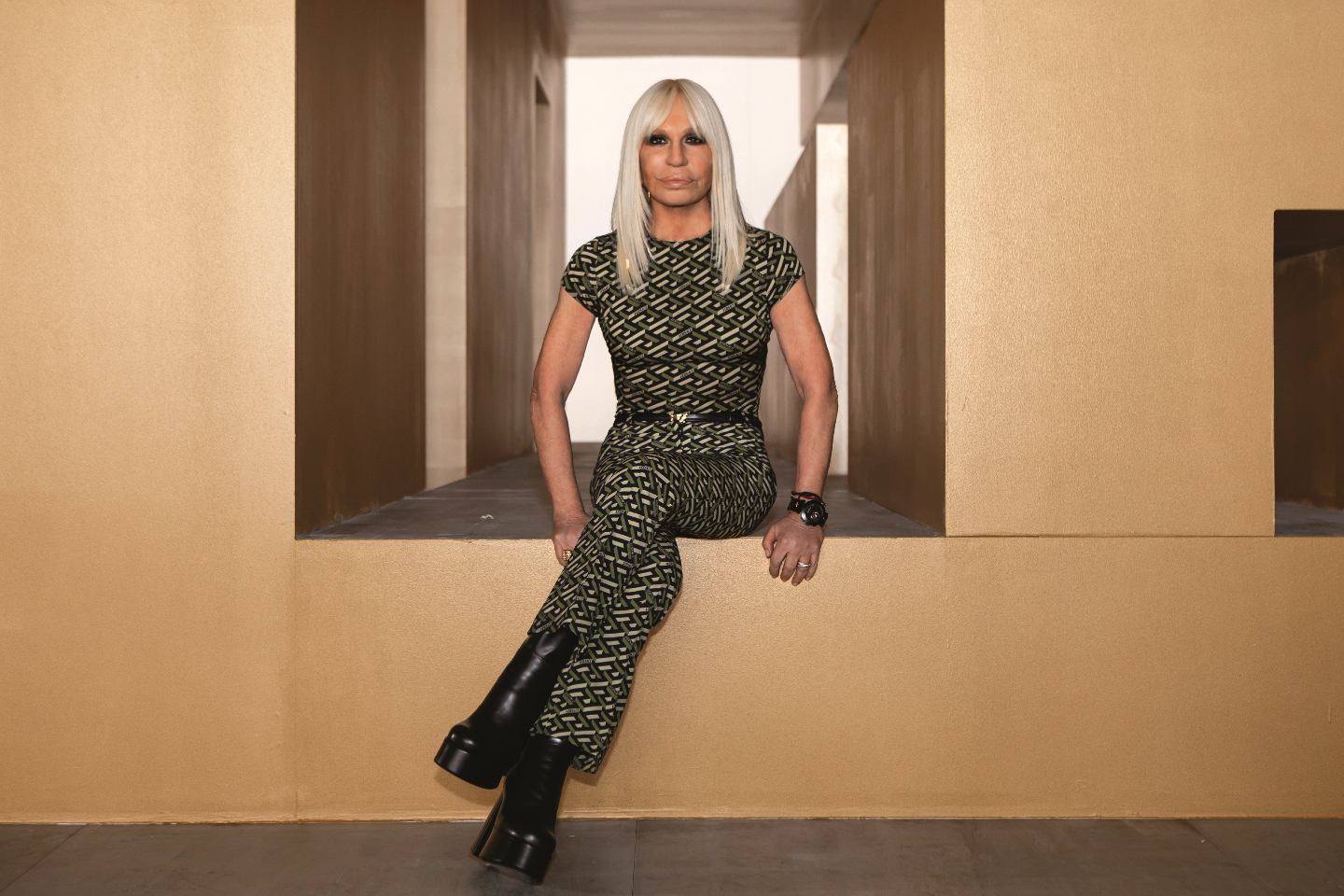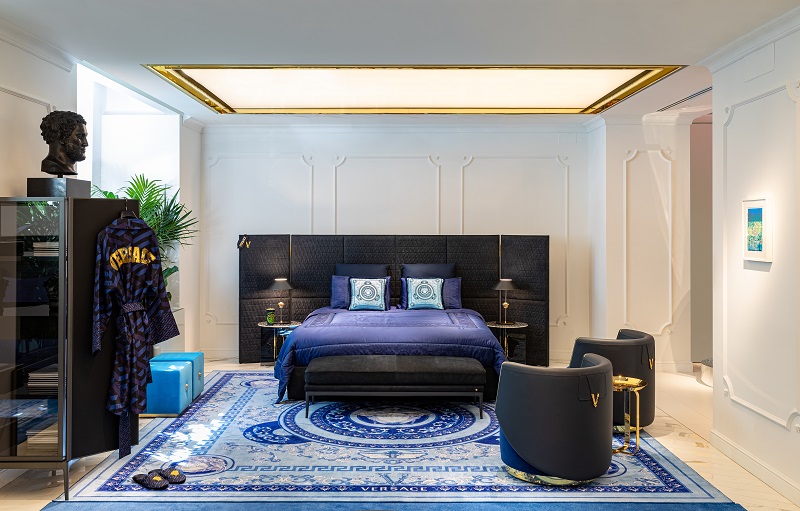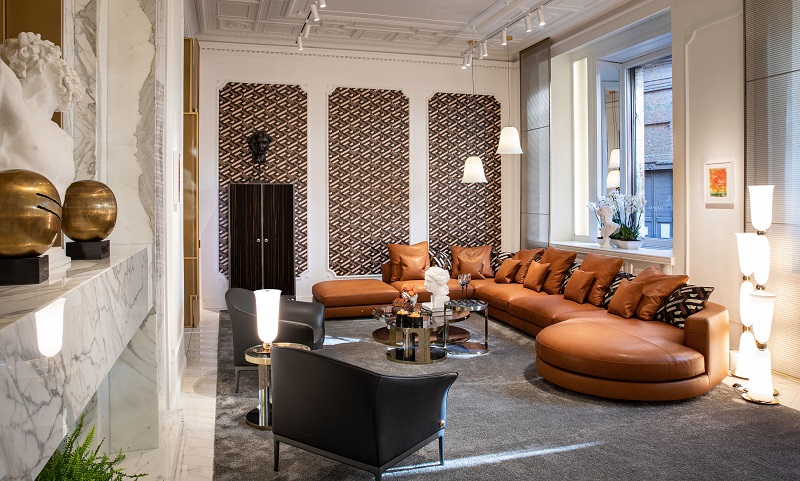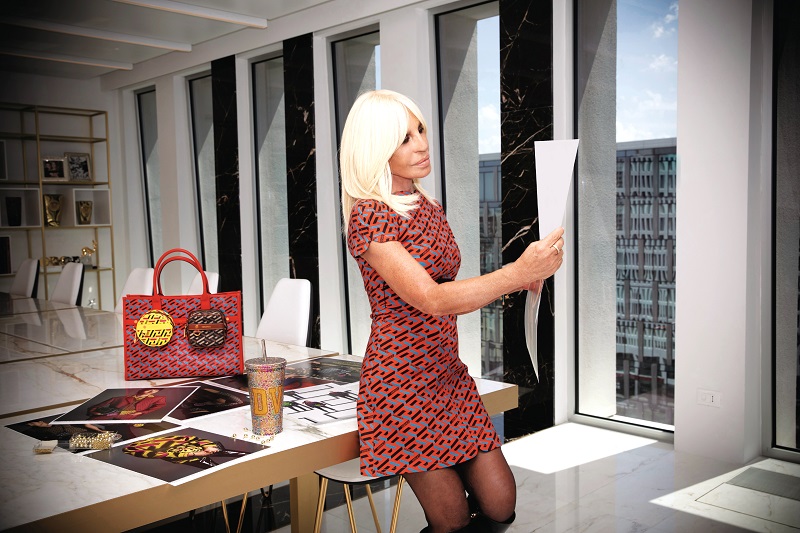
Couture, celebrity, collaborations and consistently being on the cutting edge of things are all part of Donatella Versace’s daily brief (All photos: Versace)
One word that has never veered from the Versace lexicon is “more”. From the time the house was founded in 1978 in Milan’s Via della Spiga by Giovanni Maria Versace, immortalised succinctly as “Gianni”, to the present when it is helmed with equal aplomb by his sister Donatella, more is always more for the celebrated Italian label.
“Of course I love the word,” says Donatella Versace, “but ‘more’ must always be connected with glamour, elegance and many other values that are part of the Versace DNA.” Fashion followers and industry onlookers would unanimously agree that the diminutive but arresting Donatella always has her finger on the pulse, being the first to call a trend or even setting it outright.
Modern and legendary examples include dressing Jennifer Lopez in her (in)famous plunging Jungle Dress at the 42nd Grammy Awards in 2000, creating Kim Kardashian’s red-carpet look for the 2018 Met Gala and, most recently, signing white-hot Colombian singer-songwriter Maluma (the superstar’s performance as Mariano Guzmán in the Disney hit Encanto should jog consciousness if needed) as the face of Versace’s Spring/Summer 2022 men’s campaign.
Driven by design
Born in May 1955, Donatella inherited a portion of the fashion empire Gianni built after his tragic slaying in Miami 25 years ago but has since gone on to expand it further, growing her brother’s vision yet hot-stamping it with her distinctive sense of style. Formerly head designer of Versus, the house’s diffusion label, Donatella was appointed artistic director of Versace in 1997 and now holds the position of chief creative officer, a role that spans the group’s multifaceted portfolio, which includes clothing, accessories, hotels and home furnishings.
versace_home-_via_durini_boutique_-_design_week_2021_20.jpg

“Versace was one of the first brands to create a home line to be part of a broader conversation that would be limited only by clothes,” she states. “Creating a piece of furniture is like creating a dress: If it is only beautiful with no functionality, nobody will do anything with it. It seems obvious, but it is not at all.”
Petite (she stands at just five foot two) but every inch a powerhouse, Donatella, with tongue firmly in cheek, has no qualms describing herself as “blonde, bold and bossy” — qualities she proudly announces on her Instagram profile. “I am a very curious person and I always embrace every occasion to learn something new.” This would, in part, explain the house’s latest tie-up with celebrated architectural duo and the golden couple of Italian design, Roberto Palomba and Ludovica Serafini of Palomba Serafini Associati, to create a stunning new collection of furniture and home accessories under the Versace Home label.
“I love Roberto and Ludovica,” says Donatella. “I like the fact that from the first moment we started working together, they were interested in understanding and discovering the history of Versace. When we started brainstorming, I was captivated by their incredible knowledge of design and the ideas they already had for Versace Home. The way they were able to infuse the new collection with Versace’s iconic codes and their clean, modern and elegant lines is really cool. I love their use of colour and the way they wanted to be respectful of the brand but, at the same time, bring it into the present day with their vision.”
Unveiled at Milan Design Week late last year, the joint vision for Versace Home was simple: to integrate fashion, luxury and living, creating beautiful and timeless furniture — pieces that will instantly elevate and enhance one’s life and lifestyle while offering a more immersive experience in the Versace universe. The result? An artful, seamless melding of casa and couture as exemplified in a door upholstered with runway-worthy fabric or perhaps the Venus armchair whose lissom lines evoke the statuesque models dominating the catwalk.
versace_home-_via_durini_boutique_-_design_week_2021_8.jpg

The design codes of fashion and furnishings also blend seamlessly, as showcased by the liberal use of the La Greca motif, hailed as the backbone of Versace’s Autumn/Winter 2021 collection, in the new home furnishings. Often referred to as the Greek key, it is an ancient symbol of infinity and unity. It made its first appearance in Versace’s collections in 1988, and Donatella has taken the linear meander, so named as it mimics the eternal flow of the Maeander River of Asia Minor, given it a 3D-lift and turned La Greca into the hottest pattern in fashion and design today.
“We love and believe in La Greca so much that we have put it on everything, from bags to clothing, to pieces of furniture and textiles,” Donatella affirms. “It is very Versace and I am sure it will become a loved and iconic symbol of the house. La Greca quickly became the protagonist of the AW21 collection and it is here to stay as a new pillar of the brand.
“The collection is one where aesthetics have been put at the service of functionality; a collection that is like a zip that acts as a bridge between past and present. It is a very Versace collection, where each piece has a strong soul. We all love contamination and functionality. If I have to mention the most important elective affinity, I think it can be expressed in the meeting of clean lines — in the geometry that reflects the tailored cut — with the contrast of materials, colours and details that surprise you when you look at an object.”
For the Palombas, working with Donatella was a tour de force. “It was like two oceans that meet; having her input and her guide to transfer the brand’s codes into the home collection that was an interpreter of design values and at the same time respectful of the brand itself was a great deal for us,” they say.
On the combined creative journey, Donatella says: “They wanted to see the books, the old advertising campaigns as well as the path of the brand over the years. Much research was done before arriving at the final product. We talked about the aesthetics and evolution of Versace in the past few years, how the story is part of a much broader and never intrusive narrative, the use of iconic symbols such as La Greca and the meaning that the archive has for Versace, but also how I adapted the concept of Medusa for today’s world.”
Philosophy of style
Those who wear Versace know it offers the quality of being able to transform, to add a sprinkling of fairy dust and glamorous sex appeal to the otherwise utilitarian act of dressing oneself. And it is this very quality that keeps the world baying for more. Alexandra Shulman, former editor-in-chief of British Vogue, had written of the house: “Versace is a brand that sticks to its guns — in their case, unashamedly whizz-bang sexiness. It’s a good policy in an industry where there is so much competition. At least half the battle of winning the customer must be ensuring they know what they’re getting when they hear your name.”
For Donatella, there is no distinction between dressing a body or structure. “Your home, like a dress you wear, speaks of you, your passions and your personality and therefore it is always something very intimate that needs to be respected,” she stresses. “I personally believe it is important to have a sense of humour in everything you do, not just when you style a home. However, you cannot simply say you need to have a sense of humour. You either have it or you don’t. It does not make any difference as long as you are happy with who you are. No one should judge.”
The impact of 2020 and beyond
Covid-19 has irrevocably changed the world, including the fashion industry. Imran Amed, the influential founder and CEO of leading industry website The Business of Fashion, had in fact commented on how the virus outbreak gave rise to fashion’s “existential crisis” — a statement Donatella is not disputing. “This period has made us change the way we look at the world, at people and their desires,” she agrees. “It has made us change the way of working. It has forced us to look at our entire system and ask ourselves: Is this still what people want? Is this still relevant, respectful or even okay for the world we live in?
donatella_versace_1.jpg

“Creatively speaking, I am always myself, despite the awareness that I will probably have to find, together with my team, a different message from what we had in mind months ago. Obviously, we no longer want the same things as before. So the collections that I create have to carry an even stronger, breaking message. It may be more limited in terms of the number of pieces but I would like them to speak directly to the heart and make everybody say: I want it! As chief creative officer of a fashion company, I am lucky to have a voice that can be heard by many through the messages of my clothes, the carrying of [our] products or the things I post on Instagram or say in an interview. I think inspiring others and responding to society’s needs is always my duty and this is true … even more so now.”
The past two years have also magnified already-pressing issues ranging from health to human rights, nature and seasonality. In fact, the traditional seasonal calendar used for staging fashion shows is now in danger of being rendered obsolete as designers the world over grapple with the harsh reality of climate change.
“So much has surfaced in the last couple of months linking every corner of the globe … so much to reflect upon,” says Donatella. “We were running when we had to pause. But now is the time to look back. Many might reconsider the role of fashion in all this. I have certainly thought about it on several occasions. I believe we now have the chance to make the difference, to positively impact the life of future generations. It is our responsibility to preserve the planet, promote human rights, create the basis for a better life. Fashion has a lot of work to do. It is a powerful means that can give voice to ideas and principles for future generations … not to be afraid, to dare to provoke, to indulge, to look on the bright side, to make a difference.”
Her key to life
With a fashion empire whose DNA espouses living and dressing like a rock star and whose creative head remains the poster child of glamorous fashion and pop culture, one must not forget that the house of Versace is also deeply rooted in myth and legend, possessing a profound appreciation for classical arts and architecture. The Versace family, after all, hail from Reggio di Calabria in southern Italy, a region that once formed part of Magna Graecia, colonised by the Greek empire. The Medusa head logo, synonymous with the maison, is said to have seared itself onto the consciousness of a young Gianni who saw it while playing among Reggio di Calabria’s many ancient ruins.
On Donatella’s favourite sources of inspiration, she muses philosophically: “Inspiration is a concept of yesterday because it makes you think that the collection is linked to a theme or something specific. In the world of today, this cannot be. You should be able to create strong looks and pieces by themselves because people like to mix and match them according to their personalities. Of course, the process has changed over the years … just as much as fashion has changed. Technology and social media have changed everything. I look at people, real people, the ones I see on Instagram or the ones walking the streets of Milan, Berlin and London.
“In everything I do — whether it’s a dress, a new print or, in this case, a piece of furniture — there are so many elements that come into play. Inspiration can come from so many things, some of them obvious, but you need to have the eye to see beyond the surface, to glimpse that special something that is behind everything we surround ourselves with. It could be a book I’m reading, or a piece from the archive or a song. It doesn’t make a difference. What’s important is that it makes me think. I [particularly] love Milan and its energy. Milan is the city in which I live and, every year, it has the ability to amaze me as it renews itself and connects more and more to the world while maintaining its Italian character and local peculiarity.”
She does add a caveat, though. “Today, I look a lot at social media to understand what people want. I think it’s a powerful tool to remain in touch with what is happening in society. But you need to be careful how you use it because there is a lot of pretense in what we see. At the end of the day, we are projecting an image we want other people to believe in, and it’s not always real.”
This article first appeared on Jan 31, 2022 in The Edge Malaysia.


